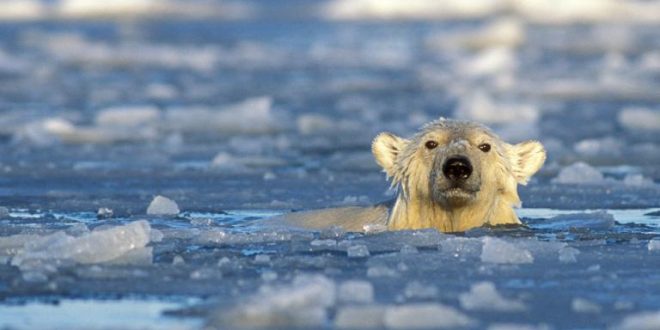Researchers have warned that disappearing summer and fall sea ice will force polar bears to swim greater distances — and spend more energy doing so — as they try to find enough food to survive.
Now they’ve gathered direct evidence that it’s already happening.
“While polar bears as a species are eminently suited to swimming, not all bears are equally able to swim long distances,” explains Andrew Derocher, a co-author on the study. “The youngest, oldest and skinniest bears are much more vulnerable to drowning. With more open water, we can expect increased mortality associated with more long distance swimming.”
Between 2004 and 2012, researchers kept tabs on the movement of 135 polar bears via satellite tracking systems, focusing on the Beaufort Sea and Hudson Bay.
In the Beaufort Sea, where scientists have observed significant ice depletion ice levels since the 1980s, more polar bears were swimming long distances compared to those in the more stable environment of Hudson Bay.
“Before, bears rarely came on shore because they didn’t have to,” said Derocher. “It was a place of a lot of maternity denning — up to 60 per cent gave birth on ice; now, 60 per cent give birth on land. In the 1980s, we had bears that would live and die on sea ice, never setting food on land. Now they have to.”
In 2012, when there were record low ice levels in the Beaufort Sea, 69 per cent of female polar bears swam more than 50 kilometres at least once. Comparatively, in years with a slower rate of ice melt, only 30 per cent of female polar bears were seen to swim long distances at least once.
“The pattern of long-distance swimming by polar bears in the Beaufort Sea shows the fingerprint of climate change,” said Nicholas Pilfold, the study’s lead author. “Swims are occurring more often in association with sea ice melting faster and moving farther from shore in the summer.”
Various factors contribute to polar bears’ likelihood of surviving long distant swims, including age, gender and size. Female polar bears with cubs tend to avoid long distances as much as possible for the sake of their cubs. Lone sub-adults, however, swam as frequently as lone adults. A sub-adult female made the longest recorded swim in the study, travelling more than 400 kilometres in nine days.
Agencies/Canadajournal
 Canada Journal – News of the World Articles and videos to bring you the biggest Canadian news stories from across the country every day
Canada Journal – News of the World Articles and videos to bring you the biggest Canadian news stories from across the country every day



